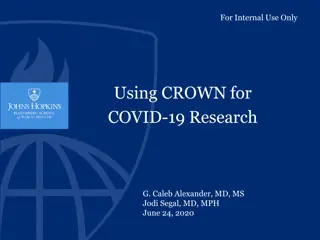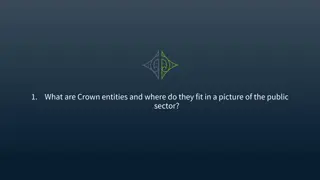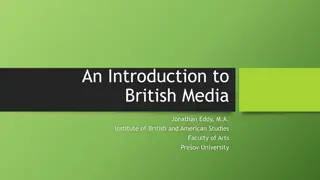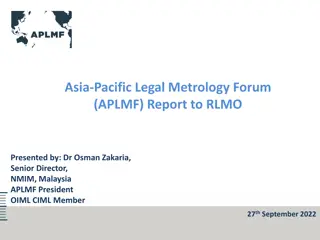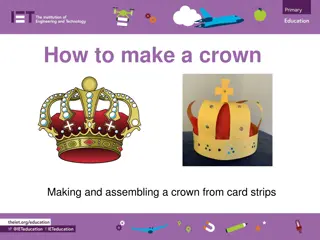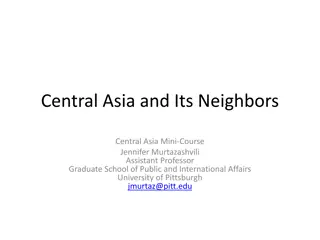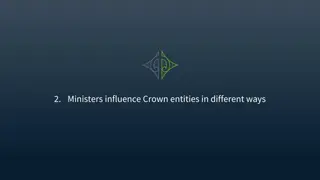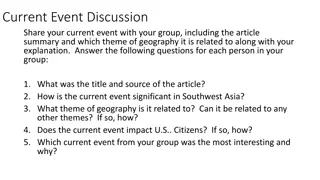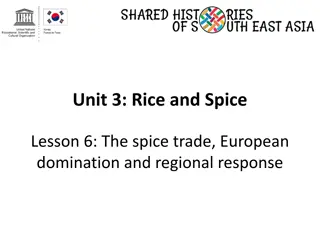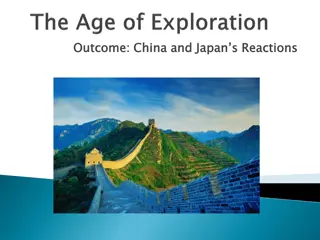European Influence in South Asia: From Mughals to British Crown
Explore the historical journey of European intervention in South Asia, beginning with the Mughal era and culminating in British colonial rule. Learn about the motivations, impact, and changing relations over the centuries, from Portuguese exploration to the rise of the British East India Company.
Download Presentation

Please find below an Image/Link to download the presentation.
The content on the website is provided AS IS for your information and personal use only. It may not be sold, licensed, or shared on other websites without obtaining consent from the author. Download presentation by click this link. If you encounter any issues during the download, it is possible that the publisher has removed the file from their server.
E N D
Presentation Transcript
Lecture 2: Keep in mind the Bigger Questions Course and section Objectives WHY, WHAT and HOW WHY Westerners came to Asia in the first place... what MOTIVATES the men from far away countries to come to this part of the world. HOW people from so far away, small countries, able to establish power over Asian countries, and The impact that they had, WHAT changed, what did not change with coming of Europeans To understand impact of Western intervention, have to understand what went on BEFORE Europeans became dominant in Asia. 2. Start with India/ SOUTH ASIA: first of the three to be colonized HISTORICAL OVERVIEW Mughals (via film)
Changing Relations Over the Centuries Sixteenth : Portuguese: Souls and Spices Seventeenth: Mughal Consolidation, EIC emergence Eighteenth: Mughal Decline, EIC political player Nineteenth: EIC replaced by British Crown after 1857 Revolt
SIXTEENTH Century (1500s) 1499 Vasco Da Gama discovers sea route to India Voyage nets profits of upto 3000 % 1526 Babur defeats last of the Delhi Sultans to establish the MUGHAL dynasty Till AKBAR s time less centralization, see map Portuguese establish some bases on western coast, and control over Indian Ocean Mughals expand inland, beginnings of vast empire Religious wars in Europe
SEVENTEENTH century 1600s Over this century, Catholic southern Europeans lose out to Protestant northern Europeans Dutch and English, primarily, displace Portuguese from control over Indian Ocean English East India Company formed in 1600, 1618 allowed to create a factory (i.e. warehouse) in SURAT Move South and then up East Coast: MADRAS (Ft St. George in 1642. In 1661 Bombay came as part of dowry when Charles II married Catherine of Braganza (Portugal) and was handed over to EIC in 1668 for 10 pounds sterling a year!!
Seventeenth Century 2 EIC a trading company, one of the first corporations Monopoly Rights to trade with the East. In return paid a handsome sum to Crown (later Parliament) Hugely profitable, create a new group of ruling elites in Britain who bought themselves prestige, power, and influence (nabobs) Exported Spices (Pepper) and later Indian textiles (calicos, fine cottons), also indigo, important dye. Blue Jeans anyone!
Seventeenth Century 3 Mughal India did not need any commodities produced by Europe at this time Europe valued Indian commodities, paid in gold and silver Hence Mughals allow the sea-borne trade to continue, as it was to mutual benefit. ANSWER TO FIRST OF SECTION QUESTIONS: WHY?
Seventeenth Century, 4 At this stage of EIC's career they COULD not play a significant role in Indian affairs. Defeating Portuguese made them important for maritime purposes, Mughal Empire way more powerful Even by end of the 17th century Europeans still very much dependent on Mughal goodwill. In 1688, eg. Aurangzeb, displeased with English misuse of privileges, drove them out of their factory at Hughli. Only after much persuasion at the court, EIC got permission to start new trade in Bengal in 1690.
Seventeenth-Eighteenth Europeans not the only important international merchants in this period. On the west coast, Gujarat and Malabar coast, merchants had long history of international trade. (Remember this when reading Ghosh s novel) Some of these traders rich enough to finance the state. Jagat Seth was one very important family in Bengal. These traders depended upon political stability. They knew Mughal system and operated within it, were protected by it in their workings in India. Internationally, made arrangements with dominant maritime powers, whether Arab, Portuguese. Dutch or British. Decline of Mughal authority in early 18th C hit these traders hard
Eighteenth Century Changes 1700s Mughal Decline Partly Systemic, Partly Internal Rivalries, Partly Rising Aspirations of Regional Leaders they had promoted Rise of Regional Powers East, BENGAL. North, AWADH (Oudh). MARATHAS in West, HYDERABAD and MYSORE in Deccan and South. Invasion of Nadir Shah in 1739, sack of Delhi only highlighted that Mughals a spent force.
Eighteenth Century 2 The English and French still to deal with some powerful local rulers in the Regions, e.g. Nawab (a title) Alivardi Khan in Bengal. Regional Powers jockeying for power among themselves. Both British and French realized the importance of their small but better trained and equipped forces in the power struggles following decline of Mughals. French concentrate on South initially, whereas, British in the east, Bengal. British able to take advantage of factions at the court in Bengal to defeat Nawab Siraj ud Daulah's army at the Battle of Plassey in 1757, a landmark date in Indian history. With Jagat Seth s help, able to buy off the major part of the Bengal rulers' armies and generals, and defeat and place a puppet in place.
Eighteenth Century 3 A few years later the MARATHAS defeated by the Afghan Ahmad Shah Abdali in 1761, clearing away the most significant Indian power of the time. In 1764, the Nawabs of Bengal and Awadh and the Mughal Emperor of Delhi (who was a pure figurehead by this time) decided to combine against the English forces, but they were no match for them. The two major victories, 1757 at Plassey and 1764 at Buxar, signaled the beginning of British political rule over India. We thus have an answer to the SECOND of our Questions: viz. HOW
Eighteenth Century 4 As tribute, in 1764 the Mughal Emperor granted the EIC "rights" to collect taxes from the province of Bengal (DIWANI), became RULERS of Bengal. A CRITICAL step, for this revenue now financed their trade, wiped out the trade deficit they ran in India trade. Taxes from Bengal used to buy the cottons. Led the EIC and the British Parliament to recognize desirability of expansion Between 1765 and 1813, series of measures taken to DELIBERATELY, CALCULATIVELY expand their rule. SUBSIDIARY ALLIANCES, e.g.. Also MILITARY ACTION. By 1799 BR EIC defeated the last major rival in Southern India -- TIPU and become the dominant force in India. All of this was to have HUGE impact on the way India was RULED, on its ECONOMY, and on its PEOPLE.
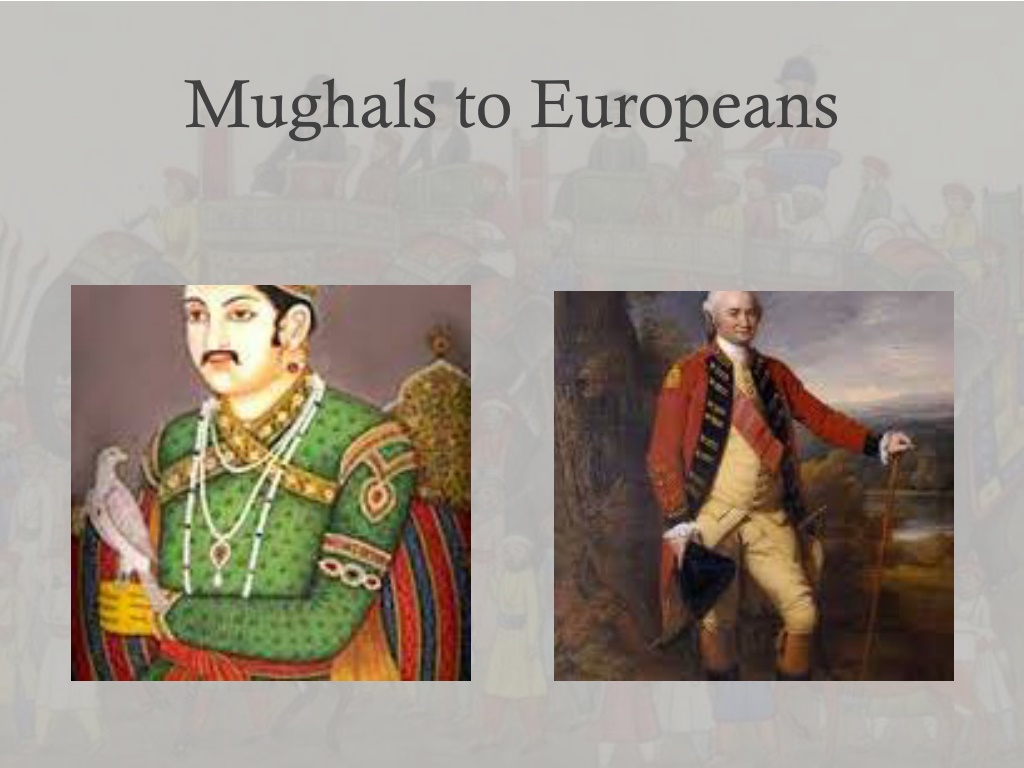





![READ⚡[PDF]✔ Emerging Space Powers: The New Space Programs of Asia, the Middle Ea](/thumb/21554/read-pdf-emerging-space-powers-the-new-space-programs-of-asia-the-middle-ea.jpg)




